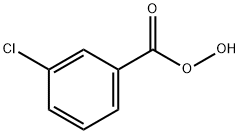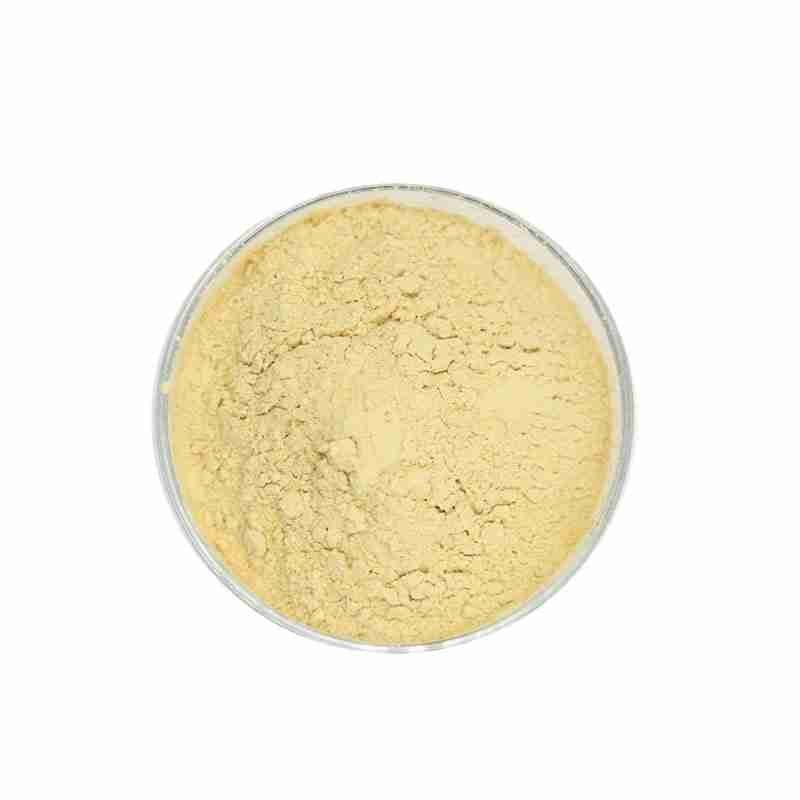3-Chloroperoxybenzoic Acid CAS# 937-14-4
3-Chloroperoxybenzoic acid (m-CPBA) is a carboxylic acid derivative, a white powder crystal, almost insoluble in water, conveniently soluble in ethanol, ether, soluble in chloroform, dichloroethane. Steady to warm, the annual disintegration price is listed below 1% at room temperature level. Disintegration rate is accelerated in liquid state.
In a polyethylene container, include 1.5 g of magnesium sulfate heptahydrate, 36g of sodium hydroxide, 360ml of water, 90ml of 30% hydrogen peroxide, 450ml of dioxane as well as ice cubes, reduced the temperature level to 15 ?? C, as well as include 52.5 g of M-chlorobenzoyl chloride, after that include ice to keep the temperature level listed below 25 ?? C. After reacting for 15 mins, include 900ml of 20% chilly sulfuric acid. After standing still, the organic layer was divided, filteringed system, and the filtrate was evaporated to eliminate the solvent (high vacuum cleaner distillation) to get 51g of 3-chloroperbenzoic acid.
发送询盘
3-Chloroperoxybenzoic Acid CAS# 937-14-4
| 3-Chloroperoxybenzoic acid Basic information |
| Chemical Properties?Uses |
| Product Name: | 3-Chloroperoxybenzoic acid |
| Synonyms: | 3-CHLOROPEROXYBENZOIC ACID;3-Chloroperoxy benzoic acid(more than 57% but not more than 86%,with 3-chorobenzoic acid);3-Chloroperoxybenzoic acid, balance 3-Chlorobenzoic acid and water, 70-75%;3-Chloroperoxybenzoic acid, 70 – 75%, (balance 3-chlorobenzoic acid and water);3-Chlorobenzeneperoxycarboxylic acid;3-Chloroperoxybenzoic Acid (contains min. 17% Water and min. 6% 3-Chlorobenzoic Acid);3-Chloroperoxybenzoic Acid (contains ca. 30% Water);3-Chloroperoxybenzoic acid ,75% |
| CAS: | 937-14-4 |
| MF: | C7H5ClO3 |
| MW: | 172.57 |
| EINECS: | 213-322-3 |
| Product Categories: | Organic Peroxide;Oxidation;Synthetic Organic Chemistry;Organic acids;PHARMACEUTICAL INTERMEDIATES;Aromatics;bc0001;top |
| Mol File: | 937-14-4.mol |
 |
|
| 3-Chloroperoxybenzoic acid Chemical Properties |
| Melting point | 69-71???C(lit.) |
| Boiling point | 244.67??C (rough estimate) |
| density | 0.56 |
| vapor pressure | 0.373Pa at 25?? |
| refractive index | 1.4580 (estimate) |
| storage temp. | 2-8??C |
| solubility | Chloroform (Slightly), Ethyl Acetate (Slightly), Methanol (Slightly) |
| pka | 7.57 (in water @ 25 ??C) |
| form | Moist Powder |
| color | White |
| PH | 4.5@25 ??C (saturated aq. sol) |
| Odor | slight pungent odor |
| Water Solubility | insoluble |
| Decomposition | >88 ??C |
| BRN | 608317 |
| Stability: | Strong oxidizing agent – contact with combustible material may cause fire. May be shock or heat sensitive. Incompatible with organic materials, strong reducing agents. |
| InChIKey | NHQDETIJWKXCTC-UHFFFAOYSA-N |
| LogP | 1.03 at 25?? |
| CAS DataBase Reference | 937-14-4(CAS DataBase Reference) |
| NIST Chemistry Reference | 3-Chloroperbenzoic acid(937-14-4) |
| EPA Substance Registry System | Benzenecarboperoxoic acid, 3-chloro- (937-14-4) |
- 2
- 2-diallylpent-4-en-1-amine
- 4
- 95-16-9
- Ammonium sulfamate
- Benzothiazole
- cas:67889-00-3ح2
- cas:83524-75-8 | pigment black 32
- cas:928836-00-4 | 2
- cas:932745-70-5 | 4
- Chemical Minerals
- Coconut diethanolamide
- Daily Chemicals
- discount
- for sale
- General pvc resin
- hexyl D-glucoside
- in stock
- Lauramidopropyl betaine
- LAURIC ACID MONOETHANOLAMIDE
- Petroleum Additives
- Plasticiser
- Ploymers
- price
- PVC
- quotation
- Raw Materal
- Remove term: Petroleum Additives Petroleum Additive
- SODIUM ETHYL 2-SULFOLAURATE
Related Products
Common English name: 5-iodo-2,3-dihydropyridazin-3-one
CAS No.: 825633-94-1
Molecular formula: C4H3IN2O
Molecular weight: 221.98
Sample: Available
Butylated Hydroxytoluene (BHT) is a synthetic phenolic antioxidant commonly added to foods, cosmetics, and packaging to prevent the oxidation of fats and oils, thereby extending their shelf life. It is also used as a preservative in a variety of products, including rubber, petroleum products, and animal feed. BHT is recognized for its effectiveness in maintaining nutrient levels, color, flavor, and odor in food products . It is known to have a melting point of 69-71??C, a boiling point of 265??C, and is soluble in ethanol, acetone, and benzene, but not in water, glycerin, or propylene glycol . BHT is also used in some dietary supplements due to its antioxidant properties . However, it is important to handle BHT with care, as it can cause skin irritation and is considered harmful if swallowed .
Chemical Name: Arabic gum
CAS No.: 9000-01-5
Appearance: powder
Silicone oil, known for its chemical designation as dimethicone or polydimethylsiloxane, is a synthetic polymer with a backbone of alternating silicon and oxygen atoms, creating a highly versatile and stable compound. It is renowned for its exceptional lubricating properties, heat resistance, and non-toxic nature, making it a staple in various industries, including cosmetics, automotive, and aerospace.
This hydrophobic, non-volatile oil is valued for its ability to provide a smooth, non-greasy feel and to form stable emulsions with other ingredients. In personal care products, silicone oil is used to impart a silky texture, reduce friction on the skin, and create a protective barrier against environmental stressors without clogging pores.
Silicone oil’s chemical inertness and resistance to oxidation contribute to its long shelf life and stability in formulations. It is also appreciated for its compatibility with a wide range of substances, allowing for the creation of multifunctional products.
In summary, silicone oil is a reliable and multifaceted ingredient, offering a combination of performance, safety, and sensory benefits. Its use in a variety of applications reflects its versatility and enduring appeal in the marketplace.
Tetraacetylethylenediamine is a fully acetylated derivative of ethylenediamine, offering a high reactivity as an intermediate in organic synthesis. Its unique structure makes it a critical component in the production of specialty chemicals and pharmaceuticals, ensuring a wide range of applications in the chemical industry.
Chemical Name: Choline salicylate
CAS No.: 2016-36-6
Molecular Formula: C12H19NO4
Molecular Weight: 241.28
Appearance: Red-Brown Crystal
Benzothiazoles are a class of chemical compounds characterized by a fused benzene and thiazole ring. They exhibit a broad spectrum of applications, particularly as antioxidants in rubber and plastic industries, enhancing product longevity and performance. Additionally, benzothiazoles serve as key intermediates in the synthesis of pharmaceuticals, contributing to the development of life-saving drugs. Recognized for their stability and reactivity, these compounds are integral to advancing material science and healthcare solutions.
Product name:Cyclopentane
Purity:96%
Appearance:White powder
Package:25kg/bag
Sample:Available
Ethylhexyl Palmitate is a skin-conditioning ester, derived from ethylhexanol and palmitic acid, that imparts moisturization and a smooth texture to cosmetic and personal care formulations. It is valued for its emollient properties, enhancing the sensory experience of skin care products.
Chemical Name: 3-Hydroxybutyric acid
CAS No.: 625-71-8
Molecular Formula: C4H8O3
Molecular Weight: 104.1
Appearance: White powder
Octocrylene is an organic compound widely recognized for its potent UV-filtering properties, making it an essential ingredient in sunscreens and other skincare products designed to protect the skin from harmful ultraviolet radiation. With the chemical name 2-(4-Methylbenzyl)-2H-benzotriazole-5-methyl, octocrylene is a stable and photostable molecule that provides broad-spectrum protection against both UVA and UVB rays.
This oil-soluble chemical is valued for its ability to absorb UV radiation effectively, converting it into heat without causing skin irritation or staining clothes. Octocrylene is often used in combination with other UV filters to enhance the sun protection factor (SPF) of formulations, ensuring a balanced and comprehensive defense against sun damage.
As a lipophilic compound, octocrylene is compatible with various cosmetic and dermatological formulations, contributing to the development of lightweight, non-greasy sunscreens. Its chemical structure allows for a high degree of safety and efficacy, making it suitable for a wide range of skin types, including sensitive skin.
In summary, octocrylene is a reliable and efficient UV filter, pivotal in the formulation of modern sunscreens that offer advanced protection against the sun’s harmful effects while maintaining skin comfort and product aesthetics.
Polyhexamethylene guanidine hydrochloride, often abbreviated as PHMG-HCl, is a high molecular weight polymeric biguanide compound known for its potent antimicrobial properties. With a chemical structure that features a long chain of methylene groups bridged by guanidine units, PHMG-HCl is effective against a broad spectrum of microorganisms, including bacteria, viruses, and fungi.
This hydrochloride salt form of PHMG is highly soluble in water and is commonly used in various applications due to its non-irritant and non-toxic nature to human skin and mucous membranes. It is widely recognized for its ability to form a colorless and odorless solution, making it an ideal choice for use in personal care products, medical disinfectants, and water treatment processes.
The versatility of PHMG-HCl lies in its cationic nature, which allows it to bind to negatively charged microbial cell walls, disrupting their integrity and leading to cell death. This mechanism of action contributes to its effectiveness as a preservative and disinfectant. Moreover, its substantivity, or the ability to adhere to surfaces, enhances its long-lasting antimicrobial activity.
In summary, Polyhexamethylene guanidine hydrochloride is a reliable and efficient antimicrobial agent, pivotal in industries where hygiene and cleanliness are paramount, offering a safe and sustainable solution for microbial control.


















